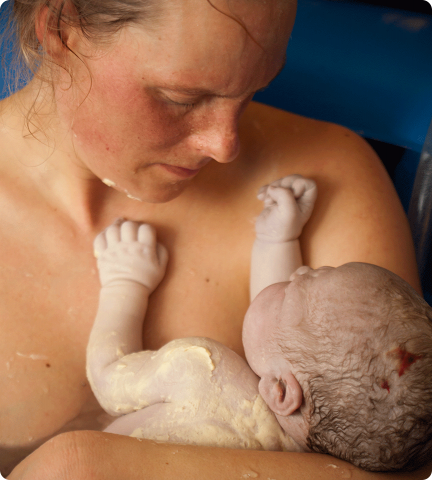The Birth
Once the woman is known to be 10 centimetres or fully dilated or she has an overwhelming urge to push, the Birth Stage or (Second Stage) has begun. The urge to push is triggered by the baby stretching nerves in the pelvic floor. Contractions are more spaced out than during transtion and lose alot of their intensity. The contractions are now expulsive, pushing the baby out of the uterus. The sensations of this stage can feel very bowel focused, which can be a surprise.
The baby makes a series of passive movements stimulated by its body moving through the internal shapes of the vagina, pelvic floor and pelvis. The head emerges slowly from the vagina, causing a stinging feeling in the perineum. The next contraction releases the baby's rear shoulder, which is followed by the second shoulder and then the baby's body slides out.
The process
The cervix is now fully dilated and open to 10 centimetres. The turbulent contractions of Transition pass. If the baby has not completed its descent into the pelvis, there may be a lull between Established Labour and the Birth stage. This is the resting phase, whilst the baby completes its rotation to line its head up with the pubic arch of the pelvis and the skull bones mold to the shape of the birth canal. As the baby descends, the head stretches the tissues of the pelvic floor which triggers the next release of oxytocin. When oxytocin levels rise in the presence of nor-adrenaline which started flowing during Transition, a reflex response happens – the irresistible urge to push.
These contractions are more spaced out than those of Transition at around 2 – 3 minutes apart. With each pushing action the baby moves out of the uterus, through the cervix and into the vaginal which unfolds and stretches to accommodate it. Pushing is a reflex response to the pressure of the baby being deep in the pelvis, it is similar to the body’s response to opening the bowel when it is full.
When the presenting part of the baby, normally it’s head, reaches the perineum it rotates underneath the pubic arch. This movement of ‘coming around the corner’ can take a good while and a fair degree of effort, but once it happens the baby’s head will appear at the vaginal opening and will stay there even in the absence of pushing contractions.
Each new contraction will now push more and more of the head into view. The vaginal tissues open out, and the woman will feel a burning sensation will develop as the skin of her perineum as it stretches to its maximum. Slowly the head crowns as the perineum goes numb. The head is born and the baby’s neck which has been slightly twisted with the movements of crowning, releases and the head now lines up with the shoulders bringing the face opposite one or other of the mother’s thighs. The next contraction releases the baby’s shoulders which are born one at a time, and then the baby’s body slips out.
The birth stage can be very fast, less than 10 minutes or it could take around 2 hours.
What you could do to help yourself
If the contractions from Transition fade off and there is a pause before you begin to push, you might use this time to rest. Pushing contractions normally occur when the baby's body stretches nerves in the pelvic floor. In order for this to happen, the baby must rotate so that the head is lined up with the pubic arch of your pelvis and the head has molded to fit the birth canal. Until then, you might choose to rest.
Pushing is an involuntary reflex, when it begins your body will simply push in the same way as your body knows how to empty your bowel. It might feel as if the baby is going to come out of your bottom and this is an odd sensation but very normal.
The more that you feel safe and undisturbed during this stage, the easier it will be to follow your body and baby's cues for what is necessary.
What partners can do to help
The key role for the partner during the birth continues to be the creation of a space in which the woman feels undisturbed, safe and warm, so that she can remain in 'the zone'. This can be more challenging to achieve during the birth stage depending upon where you have chosen to have your baby.
If you have chosen to give birth in a hospital or Birth Centre, a second midwife will come into the room for the birth. If there has been a complication during the labour, you might also find that a Registrar (student Obstetrician) and possibly a Paediatrician come into the room for the birth. If you have hired a Private Obstetrician, the midwife caring for you during labour will have kept them updated on your progress and they will make their way to you once your partner starts to push.
These additional personnel may bring your partner out of 'the zone' by providing her with instructions, turning on lights etc. If your partner can remain in 'the zone' she will be able to respond to the sensations in her body instinctively. If she is disturbed she may need considerable support, including:
- physical support with positioning – encourage upright, forward leaning positions and physically support her to change position frequently, if progress is slow;
- 'pant' with her as the baby’s head crowns and is born to slow her pushing down;
- offer her ice chips and a cool face washer for comfort;
- you could encourage your partner to reach down and touch the baby's head during crowning;
- if everything has gone smoothly, you may have the option to catch your baby and / or cut the cord.

